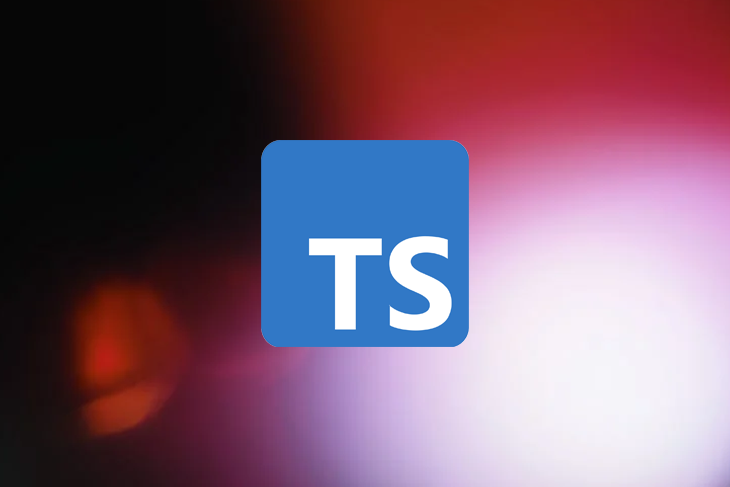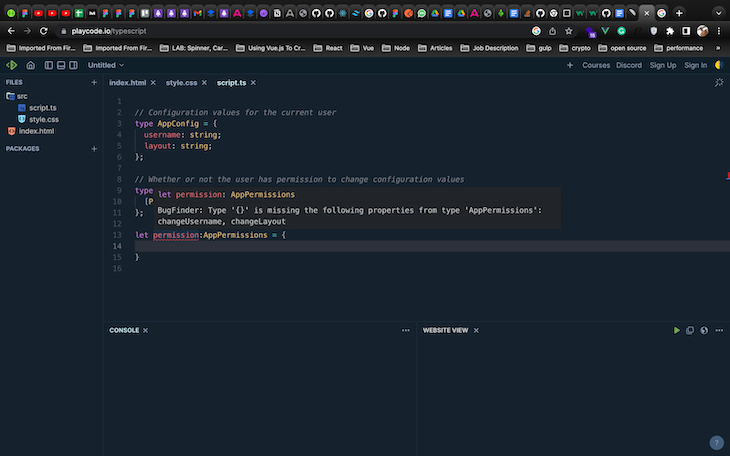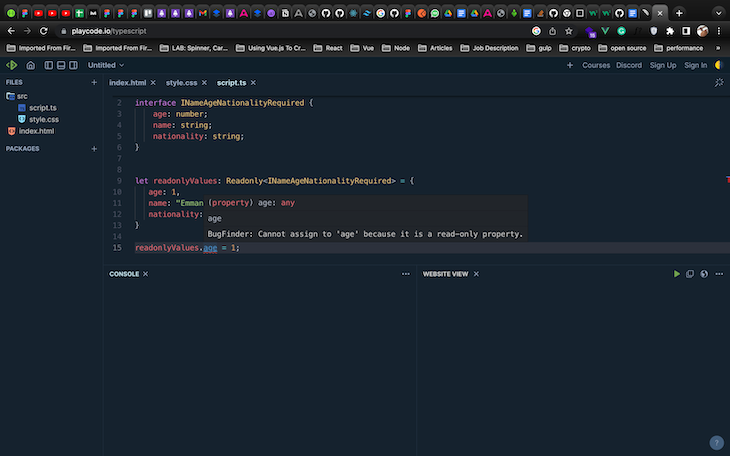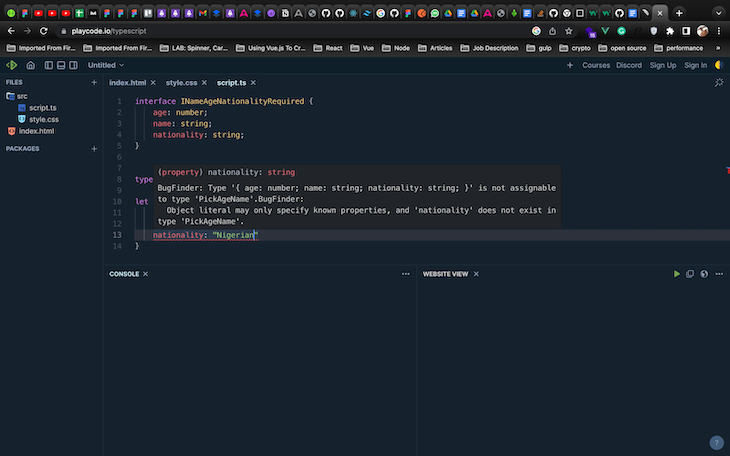
Editor’s note: This article was last updated on 8 November 2022 to add information on TypeScript utility types, like Partial<Type>, Pick<Type, Keys>, and Readonly<Type>.

Mapped types are a handy TypeScript feature that allow authors to keep their types DRY (“Don’t Repeat Yourself”). However, because they toe the line between programming and metaprogramming, mapped types can be difficult to understand at first.
In this post, we’ll cover:
The Replay is a weekly newsletter for dev and engineering leaders.
Delivered once a week, it's your curated guide to the most important conversations around frontend dev, emerging AI tools, and the state of modern software.
Using mapped types in a program is especially useful when there is a need for a type to be derived from (and remain in sync with) another type:
// Configuration values for the current user
type AppConfig = {
username: string;
layout: string;
};
// Whether or not the user has permission to change configuration values
type AppPermissions = {
changeUsername: boolean;
changeLayout: boolean;
};
This example is problematic because there is an implicit relationship between AppConfig and AppPermissions. Whenever a new configuration value is added to AppConfig, there must also be a corresponding boolean value in AppPermissions.
It is better to have the type system manage this relationship than to rely on the discipline of future program editors to make the appropriate updates to both types simultaneously.
We’ll delve into the specifics of the mapped types syntax later on, but here is a preview of the same example using mapped types instead of explicit types:
// Configuration values for the current user
type AppConfig = {
username: string;
layout: string;
};
// Whether or not the user has permission to change configuration values
type AppPermissions = {
[Property in keyof AppConfig as `change${Capitalize<Property>}`]: boolean
};
let permission:AppPermissions = {
}
TypeScript will throw the following error:

Adding changeUsername and changeLayout to the permission variable as follows will resolve this error:
let permission:AppPermissions = {
changeLayout: true,
changeUsername: false
}
Mapped types build upon each of these concepts and TypeScript features.
In a computer science context, the term “map” means to transform one thing into another, or, more commonly, refers to turning similar items into a different list of transformed items. Likely the most familiar application of this idea is Array.prototype.map(), which is used in everyday TypeScript and JavaScript programming:
[1, 2, 3].map(value => value.toString()); // Yields ["1", "2", "3"]
Here, we’ve mapped each number in the array to its string representation. So a mapped type in TypeScript means we’re taking one type and transforming it into another type by applying a transformation to each of its properties.
TypeScript authors can access the type of a property by looking it up by name:
type AppConfig = {
username: string;
layout: string;
};
type Username = AppConfig["username"];
In this case, the resolved type of Username is string. For more information on indexed access types, see the official docs.
Index signatures are handy for cases when the actual names of the type’s properties are not known, but the type of data they will reference is known:
type User = {
name: string;
preferences: {
[key: string]: string;
}
};
const currentUser: User = {
name: 'Foo Bar',
preferences: {
lang: 'en',
},
};
const currentLang = currentUser.preferences.lang;
In this example, the TypeScript compiler reports that the type of currentLang is string rather than any. This functionality, in conjunction with the keyof operator detailed below, is one of the core components that make mapped types possible. For more information on index signatures, see the official documentation on object types.
A union type is a combination of two or more types. It signals to the TypeScript compiler that the type of the underlying value could be any one of the types included in the union. This is a valid TypeScript program:
type StringOrNumberUnion = string | number; let value: StringOrNumberUnion = 'hello, world!'; value = 100;
Here is a more complicated example that shows some of the advanced protection the compiler can offer with union types:
type Animal = {
name: string;
species: string;
};
type Person = {
name: string;
age: number;
};
type AnimalOrPerson = Animal | Person;
const value: AnimalOrPerson = loadFromSomewhereElse();
console.log(value.name); // No problem, both Animal and Person have the name property.
console.log(value.age); // Compilation error; value might not have the age property if it is an Animal.
if ('age' in value) {
console.log(value.age); // No problem, TS knows that value has the age property, and therefore it must be a Person if we're inside this if block.
}
See the docs on everyday types for more information on union types.
keyof type operatorThe keyof type operator returns a union of the keys of the type passed to it. For example:
type AppConfig = {
username: string;
layout: string;
};
type AppConfigKey = keyof AppConfig;
The AppConfigKey type resolves to "username" | "layout". Note that this also works in tandem with index signatures:
type User = {
name: string;
preferences: {
[key: string]: string;
}
};
type UserPreferenceKey = keyof User["preferences"];
The UserPreferenceKey type resolves to string | number (number because accessing JavaScript object properties by number is valid syntax). Read about the keyof type operator here.
Though not strictly required for implementing mapped types, tuples are a common construct in typical TypeScript programs. Tuples are a special kind of array type, where the elements of the array may be of specific types at specific indices. They allow the TypeScript compiler to provide greater safety around arrays of values, particularly when those values are of different types.
For example, the TypeScript compiler is able to provide type safety for the various elements of the tuple:
type Currency = [number, string];
const amount: Currency = [100, 'USD'];
function add(values: number[]) {
return values.reduce((a, b) => a + b);
}
add(amount);
// Error: Argument of type 'Currency' is not assignable to parameter of type 'number[]'.
// Type 'string' is not assignable to type 'number'.
Try this code in the TypeScript playground.
TypeScript is also able to alert us when accessing an element at an index beyond the tuple’s defined types:
type LatLong = [number, number]; // Note that we're not using number[] here. const loc: LatLong = [48.858370, 2.294481]; console.log(loc[2]); // Error: Tuple type 'LatLong' of length '2' has no element at index '2'.
Try this code in the TypeScript playground.
Now that we’ve covered the foundations upon which TypeScript’s mapped types feature is built, let’s walk through a detailed real-world example. Suppose our program keeps track of electronic devices and their manufacturers and prices. We might have a type like this to represent each device:
type Device = {
manufacturer: string;
price: number;
};
Now, we’d like to ensure that we have a way to display those devices to the user in a human-readable format, so we’ll add a new type for an object that can format each property of a Device with an appropriate formatting function:
type DeviceFormatter = {
[Key in keyof Device as `format${Capitalize<Key>}`]: (value: Device[Key]) => string;
};
Let’s pull this code block apart, piece by piece.
Key in keyof Device uses the keyof type operator to generate a union of all keys in Device. Putting it inside of an index signature essentially iterates through all properties of Device and maps them to properties of DeviceFormatter.
format${Capitalize<Key>} is the transformation part of the mapping and uses key remapping and template literal types to change the property name from x to formatX.
(value: Device[Key]) => string; is where we use the indexed access type Device[Key] to indicate that the format function’s value parameter is of the type of the property we are formatting. So, formatManufacturer takes a string (the manufacturer) while formatPrice takes a number (the price).
Here’s what the DeviceFormatter type looks like:
type DeviceFormatter = {
formatManufacturer: (value: string) => string;
formatPrice: (value: number) => string;
};
Now, let’s suppose we add a third property, releaseYear, to our Device type:
type Device = {
manufacturer: string;
price: number;
releaseYear: number;
}
Thanks to the power of mapped types, the DeviceFormatter type is automatically expanded to look like this without any additional work on our part:
type DeviceFormatter = {
formatManufacturer: (value: string) => string;
formatPrice: (value: number) => string;
formatReleaseYear: (value: number) => string;
};
Any implementations of DeviceFormatter must add the new function or compilation will fail. Voilà!
Suppose now that our program not only needs to keep track of electronic devices but also accessories for those devices:
type Accessory = {
color: string;
size: number;
};
Again, we want a type for an object that can provide string formatting functions for all the properties of Accessory. We could implement an AccessoryFormatter type, similar to how we implemented DeviceFormatter, but we end up with mostly duplicate code:
type AccessoryFormatter = {
[Key in keyof Accessory as `format${Capitalize<Key>}`]: (value: Accessory[Key]) => string;
};
The only difference is that we’ve replaced references to the Device type with Accessory. Instead, we can create a generic type that takes Device or Accessory as a type argument and produces the desired mapped type. Traditionally, T is used to represent the type argument.
type Formatter<T> = {
[Key in keyof T as `format${Capitalize<Key & string>}`]: (value: T[Key]) => string;
}
Note that we have to make one slight change to our property name transformation. Because T could be any type, we don’t know for sure that Key is a string (for example, arrays have number properties), so we take the intersection of the property name and string to satisfy the constraint imposed by Capitalize.
See the TypeScript documentation on generics for more detail on how they work.
Now, we can replace our bespoke implementations of DeviceFormatter and AccessoryFormatter to use the generic type instead:
type DeviceFormatter = Formatter<Device>; type AccessoryFormatter = Formatter<Accessory>;
Here is the full final code:
type Device = {
manufacturer: string;
price: number;
releaseYear: number;
};
type Accessory = {
color: string;
size: number;
};
type Formatter<T> = {
[Key in keyof T as `format${Capitalize<Key & string>}`]: (value: T[Key]) => string;
};
type DeviceFormatter = Formatter<Device>;
type AccessoryFormatter = Formatter<Accessory>;
const deviceFormatter: DeviceFormatter = {
formatManufacturer: (manufacturer) => manufacturer,
formatPrice: (price) => `$${price.toFixed(2)}`,
formatReleaseYear: (year) => year.toString(),
};
const accessoryFormatter: AccessoryFormatter = {
formatColor: (color) => color,
formatSize: (size) => `${size} inches`,
};
Try this code in the TypeScript playground.
Mapped types are not the only useful construct we can build within the type system. Using the same foundational concepts, we can also create custom utility types that allow other engineers to derive their own types and keep their programs DRY.
Mapped types are so fundamental that some mapped type definitions are adopted as standard TypeScript utility types — like the OptionalInterface definition below:
interface INameAgeNationalityRequired {
age: number;
name: string;
nationality: string;
}
type OptionalInterface<T> = {
[K in keyof T]?: T[K];
}
let allOptional: OptionalInterface<INameAgeNationalityRequired> = {}
This makes all props in T optional and adopted as a standard TypeScript type called Partial``<T>:
type Partial<T> = {
[P in keyof T]?: T[P];
};
TypeScript ships with a number of useful utility types out of the box.
Partial<Type> returns a type of the same shape as Type, but where all the keys are optional. An example where this utility type may be useful is when a user fills out a form where user input is optional and falls back to a set of default values. The Partial<T> type would represent the user’s input, while the original type would represent the user’s input blended with the default values.
Similarly, Readonly<Type> returns a type of the same shape as T, but where all the keys are read only:
type Readonly<T> = {
readonly [P in keyof T]: T[P];
};
We can use Readonly<T> as follows:
let readonlyValues: Readonly<INameAgeNationalityRequired> = {
age: 1,
name: “Emmanuel”,
nationality: "Nigerian"
}
Here, we have used the Readonly mapped type with the INameAgeNationalityRequired interface to create the readonlyValues variable. Because the INameAgeNationalityRequired interface requires name, age and nationality properties, we have provided values for these properties.
Now, if we try to assign values to any of these properties (age and name) as follows:
readonlyValues.age = 1;
TypeScript will throw the following error:
error TS2540: Cannot assign to 'age' because it is a read-only property.

Outside of the standard mapped types of Partial and Readonly, there are two other interesting mapped types:
Pick<Type, Keys>As the name implies, the Pick mapped type is used to construct a type that picks properties of another type:
type PickAgeName = Pick<INameAgeNationalityRequired, "age" | "name">;
Here, we construct a new type PickAgeName using the Pick mapped type, and provide two generic types. The first generic type is the INameAgeNationalityRequired interface, and the second generic type is a string literal, which matches keys of the original type INameAgeNationalityRequired. Essentially, the Pick mapped type will select a set of properties from the original type to apply to the new type.
The PickAgeName type defined above can be used as follows:
let pickAgeAndName: PickAgeName = {
age: 22,
name: "Paul"
}
If we decide to add any other property to pickAgeAndName variable, TypeScript will throw the following error:

Pick<Type, Keys> returns a type derived from Type that only contains the keys specified by Keys. This utility type is useful for areas of a program that don’t require the full type, like related entities in an API response — perhaps the /user API endpoint returns a user with all their data (name, username, attributes, etc.), whereas the /team API endpoint returns a list of users with only partial user data (username only, for example).
Using generics, index access types, union types, and other tools as described in this article, we can easily add our own utility types for use alongside TypeScript’s default utility types.
TypeScript’s mapped types provide a powerful way to keep related types in sync automatically. They can also help prevent bugs by keeping types DRY and preventing the need to repetitively type (or copy and paste) similar property names.
Happy typing!

LogRocket lets you replay user sessions, eliminating guesswork by showing exactly what users experienced. It captures console logs, errors, network requests, and pixel-perfect DOM recordings — compatible with all frameworks, and with plugins to log additional context from Redux, Vuex, and @ngrx/store.
With Galileo AI, you can instantly identify and explain user struggles with automated monitoring of your entire product experience.
Modernize how you understand your web and mobile apps — start monitoring for free.

AI-first debugging augments traditional debugging with log clustering, pattern recognition, and faster root cause analysis. Learn where AI helps, where it fails, and how to use it safely in production.

Container queries let components respond to their own layout context instead of the viewport. This article explores how they work and where they fit alongside media queries.

React Server Components vs Islands Architecture: Learn how each reduces client JavaScript, impacts hydration and interactivity, and which trade-offs matter for production performance.

Large hosted LLMs aren’t always an option. Learn how to build agentic AI with small, local models that preserve privacy and scale.
Hey there, want to help make our blog better?
Join LogRocket’s Content Advisory Board. You’ll help inform the type of content we create and get access to exclusive meetups, social accreditation, and swag.
Sign up now
4 Replies to "Mastering TypeScript mapped types"
This was incredibly helpful and written with such clarity I’m in awe.
Thanks, Rob! Happy to hear it!
Great article! Typescript’s documentation is concise but it’s always nice to have a second look of Typescript’s fundamentals
Thanks, Ignacio!